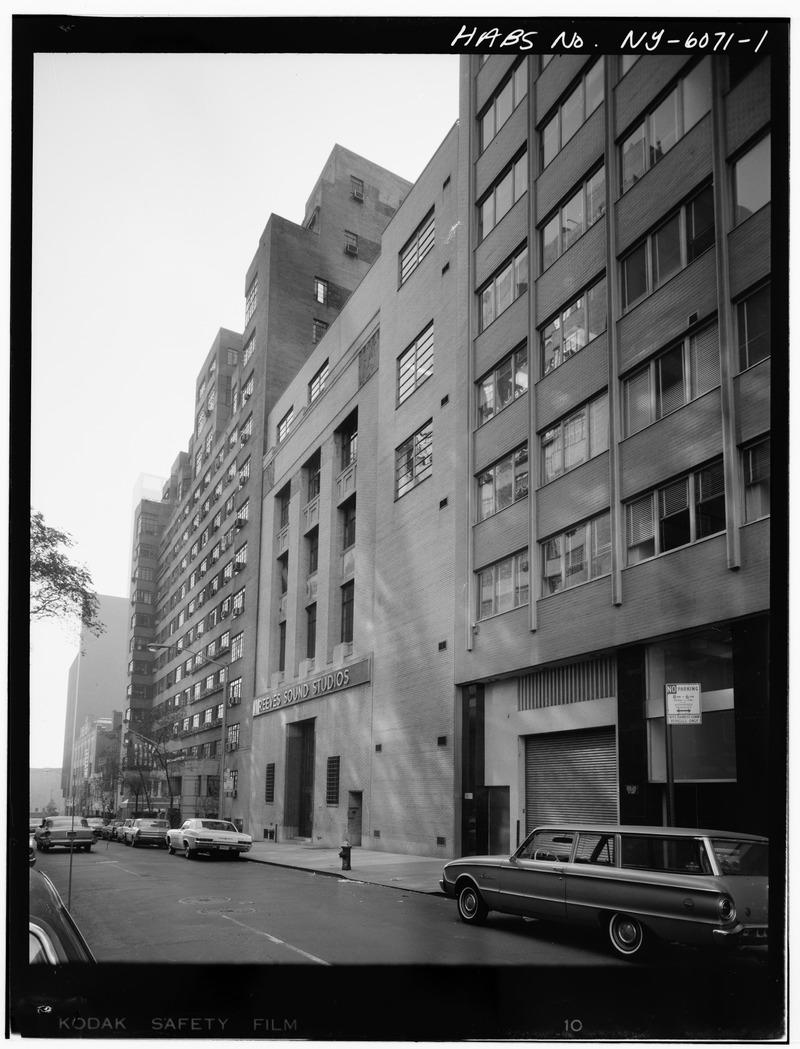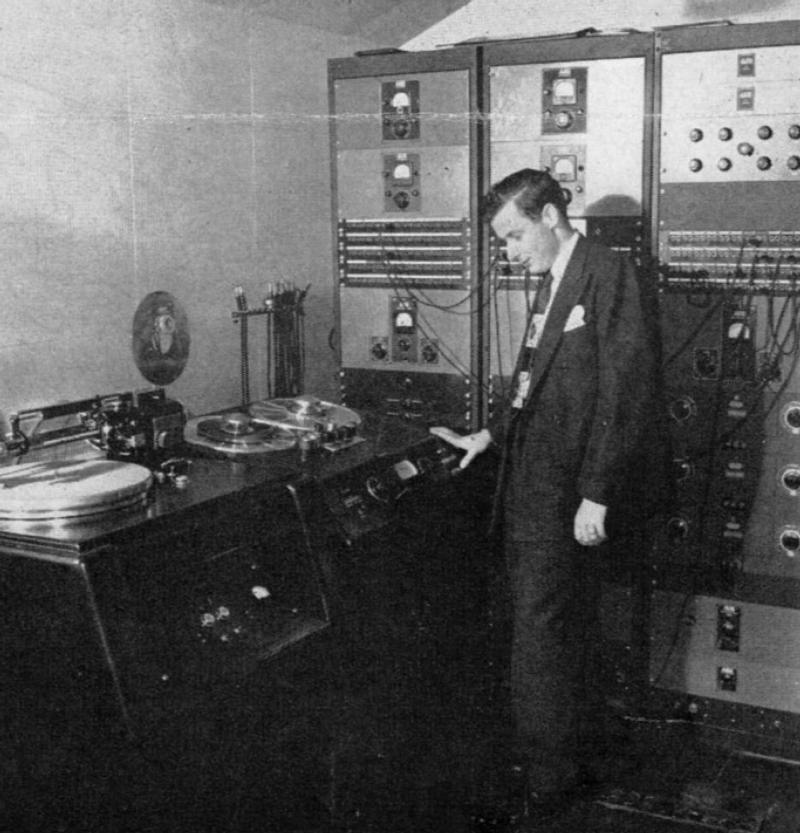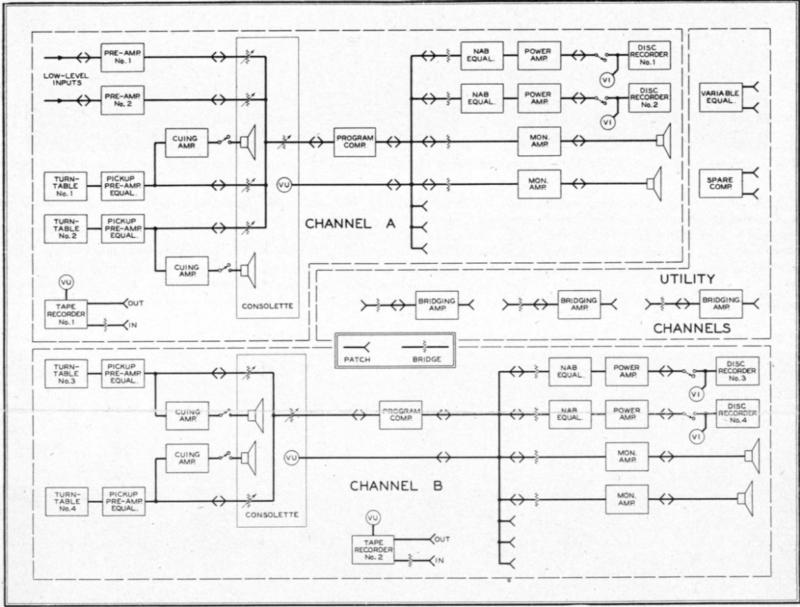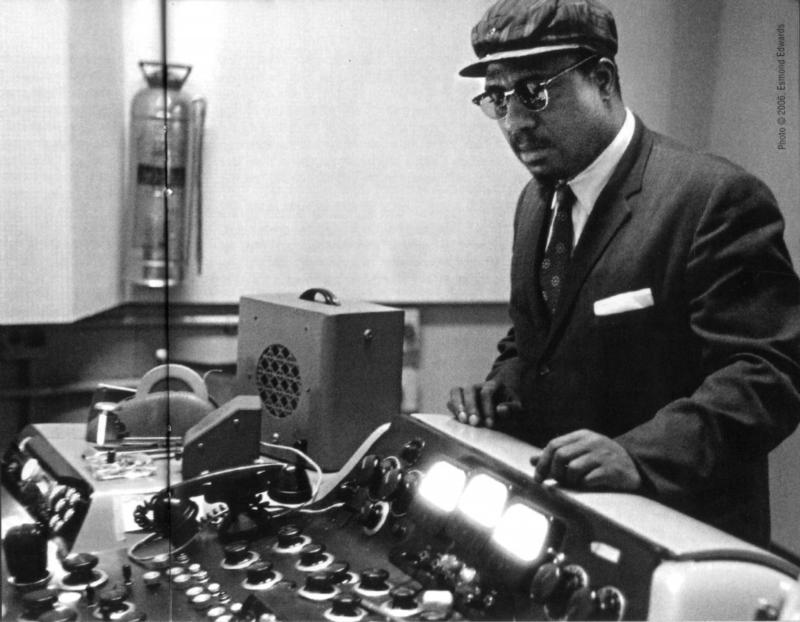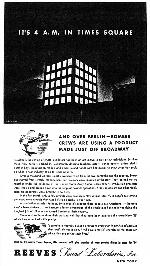
Posted By: BRADLEY STONE (NB9M) Posted: 04/12/2019 Historic 04/12/2019 |
Hazard E. Reeves - audio pioneer and defense contractorMaking crystals in midtown Manhattan during WWII |
|
Hazard E. Reeves (1906-1986) may not be a household name, but his work is well known to every moviegoer. He was an American pioneer in sound and sound electronics, and introduced stereophonic sound for motion pictures. He met Fred Waller at the 1939 World's Fair and saw the potential of Waller's "Vitarama" system which he invested in and which soon became the movie industry standard known as Cinerama, one of the 60 companies Reeves was president of. Following the war, in 1946, Reeves founded the Reeves Soundcraft Corporation and directed the operation of a number of companies manufacturing a variety of products including recording tape and film, record discs, wire cable, television tubes and cameras and precision recording equipment. Reeves introduced magnetic recording to the film industry in 1948. He formed Reeves Instrument Co. (RICO) to undertake defense related projects and became a leading manufacturer of computer and radar systems. RICO operated the "Project Cyclone" laboratory for simulation of guided missiles, and developed several radar/computer/communications) systems ("Q" systems) for the Strategic Air Command. But during WWII, like nearly all companies, Reeves commercial business was put on hold as the company was pressed into service as a manufacturer of one of the most needed components for the war effort: quartz crystals. The advertisement below spells out the company's role in stark black-and-white - here is the text: IT’S 4 A.M. IN TIMES SQUARE AND OVER BERLIN – BOMBER CREWS ARE USING A PRODUCT MADE JUST OFF BROADWAY Previously, the cutting of crystal oscillators had been an art known to only a few technicians. But then these New Yorkers pitched in: Debutantes, dancing teachers, actors, stenographers, artists, clerks, butcher boys, beauticians, models and others joined hands with housewives to show what they could do when a war industry came to Times Square. Over a thousand workers (mostly women) came from the five boroughs and the suburbs. Everyone started from scratch. Management and workers were unskilled at the start. They learned the job together under the guidance of the United States Army Signal Corps experts. Production processes were studied and broken down into the simplest possible operations. X-Ray equipment and other highly scientific apparatus were brought in to help. In the first month, only a few crystal were produced. Now a year later, these people are turning out many more crystals than was believed possible a year ago. A production miracle? Perhaps. But maybe it’s because these people are Americans – because they’re New Yorkers…or because a large percentage of the employees have relatives doing the toughest job of all – in the Armed Service of their country. These workers have done their work so well that they have been awarded the Army-Navy “E” which they accept with this pledge: “I promise to wear this pin as a promise to every man in our Armed Services that, until this war is won, I will devote my full energies to the cause for which they are giving their lives.” First to fly above Times Square, this pennant will give promise of even greater things in store for ’44. Watch the documentary "Crystals Go To War", which was produced in 1943 by the Reeves Sound Laboratory, at the link on the "VIDEOS" page. |
|
Related Images
Click on the image title or on the image itself to open the full-sized image in a separate window.Latest Articles
|
Crystal Replacement
Posted: 02/38/2024
Comments: 0 |
How good can a crummy receiver be?
Hundreds of different simple SDR receivers have been designed around Dan Tayloe's Quadrature Sampling Detector or QSD. Mine add nothing to the state of the art, and in fact subtract things, as I like minimalist solutions and the QSD is right in that sweet spot. Following the evolution of Tayloe's design I delete the resistors in series with the sample lines for inst... READ MORE |

Technical
Posted: 02/37/2024
Comments: 0 |
What's in a number (3253)?
The FST3253 dual four-to-one mux/demux IC has long been used as a "Tayloe Detector" or QSD (and QSE) in low-cost SDRs. They provide incredible performance for such a simple circuit, converting RF to baseband IQ with low loss and the ultimate in simplicity. Unfortunately the original FST3253 part has become obsolete and while substitutes are available, this is where the... READ MORE |

Vintage Ham Radio
Posted: 02/32/2024
Comments: 0 |
The Stancor 10P Transmitter
There weren't really many commercial transmitters in the 1930s as most hams built their own. But many of the ones that were offered came from the transformer companies who had two chances to profit. First, from those who would buy the kit, and two, from those would would see it in the (free) booklets the companies provided to their distributors who would then sell the iron to ham... READ MORE |

Vintage Ham Radio
Posted: 12/355/2023
Comments: 0 |
The Care and Feeding of the EF Johnson Courier amplifier
The EF Johnson "Courier" is a grid-driven amplifier using two 811A tubes. Switching is provided for operating in either class C for CW or as a class B linear amplifier for AM or SSB. Rated power is 500 watts input for CW, 500 watts PEP input for SSB, and 200 watts input for double-sideband AM with carrier. Since all amateur power levels were meas... READ MORE |

Historic
Posted: 11/329/2023
Comments: 0 |
TV Duplexer
Some things are interesting, even if totally useless nowadays. Such is the case with the Philco 426-3034 Crossover Kit for UHF TV. What the heck is that? Well, back in the late 50s, UHF television stations operating on channels 14-83 started to appear in many areas of the US where viewers had a VHF-only TV antenna, and in many cases an externa UHF converter was... READ MORE |

Crystal Replacement
Posted: 11/327/2023
Comments: 0 |
Replacing failed crystals
For decades, quartz crystals were used everywhere a stable frequency source was needed, even in some applications that depended on overtone (harmonic) behavior into the VHF range. These crystals were less stable and more dependent on circuit parameters that fundamental types and thus more problematic. Such was the case with the 94 MHz crystal in the 2 meter converter ... READ MORE |

Historic
Posted: 11/315/2023
Comments: 0 |
My Own Ham Radio Story by W9RAN
Everyone has a story of how they got involved in ham radio - this is mine. It started much earlier, including receiving a Knight Kit Span Master shortwave radio for Christmas in about 1963, at age 12. I'll never forget the night my dad and I finished building it and I wanted to try it out. It came with a 50 ft. antenna which was still coiled up - but ... READ MORE |

Technical
Posted: 09/267/2023
Comments: 0 |
Hot to simulate vacuum tubes in LTSpice
LTSice is a powerful simulation tool that is provided free by Linear Technology Corp. It comes with a complete library of passive and common analog solid-state components but if you want to use it to simulate vacuum tubes, it doesen't work as-is. Even though triode and pentode symbols can be found in the "Misc" folder, they are just schematic symbols and... READ MORE |
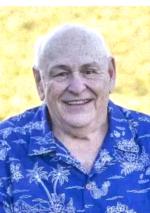
Friends Remembered
Posted: 07/208/2023
Comments: 0 |
Merv Schweigert, K9FD (SK)
Comments from Robert Nickels W9RAN, July 27, 2023: There is nothing worse for a ham radio operator than to see a beloved friends callsign with the letters "SK" behind them. Yet sadly, that's what happened on July 23, 2023, when I learned of the passsing of Merv Schweigert, K9FD. While many of our ham radio interests were different - Me... READ MORE |
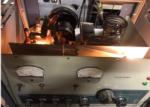
Vintage Ham Radio
Posted: 01/19/2023
Comments: 0 |
"Winter Projects"
I know many of us who enjoy restoring and repairing vintage gear look forward to winter when there is less competition for time and energy, and a chance to really make a dent in our "to be fixed" piles. A couple of years ago I set time aside for "Heathkit Singlebander Week" and went through every one of them I had, with the result that they're all working ... READ MORE |
